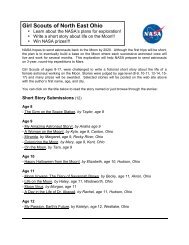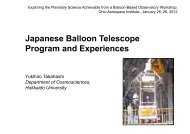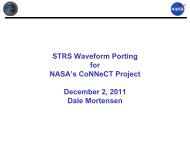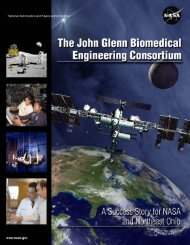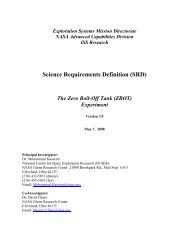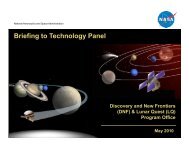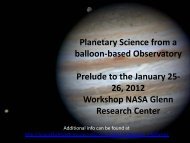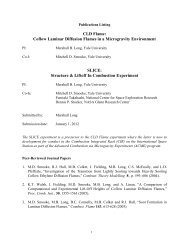Amusement Park Physics With a NASA Twist - Space Flight Systems ...
Amusement Park Physics With a NASA Twist - Space Flight Systems ...
Amusement Park Physics With a NASA Twist - Space Flight Systems ...
Create successful ePaper yourself
Turn your PDF publications into a flip-book with our unique Google optimized e-Paper software.
<strong>NASA</strong> Connection—Bumper Cars<br />
When bumper cars are not spinning in circles, they travel<br />
along linear paths. They also provide firsthand experience<br />
with Newton’s laws of motion.<br />
Three bumper cars colliding are an<br />
excellent example of Newton’s laws of<br />
motion.<br />
How do Newton’s laws of motion apply to bumper cars<br />
• First law of motion: Before the driver has pressed on the<br />
"gas" pedal, the car is at rest. The driver, after pushing on<br />
the pedal, begins traveling in a straight line at a steady<br />
speed. Unless the driver hits another car, steps on the<br />
brakes, turns the steering wheel, or accelerates the car (so<br />
that there is no net external force acting), the motion of the<br />
car will remain in a straight line. So unless a net external<br />
force acts on an object, it will remain at rest if at rest or<br />
move in a straight line at a constant speed if in motion.<br />
• Second law of motion: The driver and the car are both<br />
moving at a constant rate across the floor when another<br />
car that is moving faster than the first driver hits the car.<br />
The car that is hit will either speed up or slow down,<br />
depending on the direction of the hit, due to the force of<br />
impact. The harder the car is hit, the greater the change of<br />
speed or acceleration.<br />
• Third law of motion: What happens if two drivers collide<br />
head-on with each other Both cars will bounce backward<br />
after collision. Each car exerts an equal and opposite force<br />
on the other car causing them both to accelerate and move<br />
in the opposite direction. For every action or force, there is<br />
an equal and opposite reaction force.<br />
Rockets are a very good example of Newton’s laws of motion<br />
in action. The rocket starts out on a launch pad, where it is not<br />
moving. The amount of thrust required for the rocket to move<br />
upward depends on the mass of the rocket and the mass of<br />
the payload (the experiment) that it is carrying. As the rocket<br />
engines fire, the exhaust thrusts down while the rocket gets<br />
propelled upward.<br />
Thrust causes a Black Brant XII<br />
sounding rocket to take off.<br />
Sounding rockets are another microgravity research tool used<br />
by scientists. The rockets provide scientists with 6 to 8<br />
minutes of microgravity by coasting after the rocket engines<br />
are turned off. Scientists who have an experiment that needs<br />
more microgravity flight time than a KC–135 to obtain appropriate<br />
data will sometimes use a sounding rocket.<br />
66<br />
<strong>Amusement</strong> <strong>Park</strong> <strong>Physics</strong> <strong>With</strong> a <strong>NASA</strong> <strong>Twist</strong><br />
EG–2003–03–010–GRC



